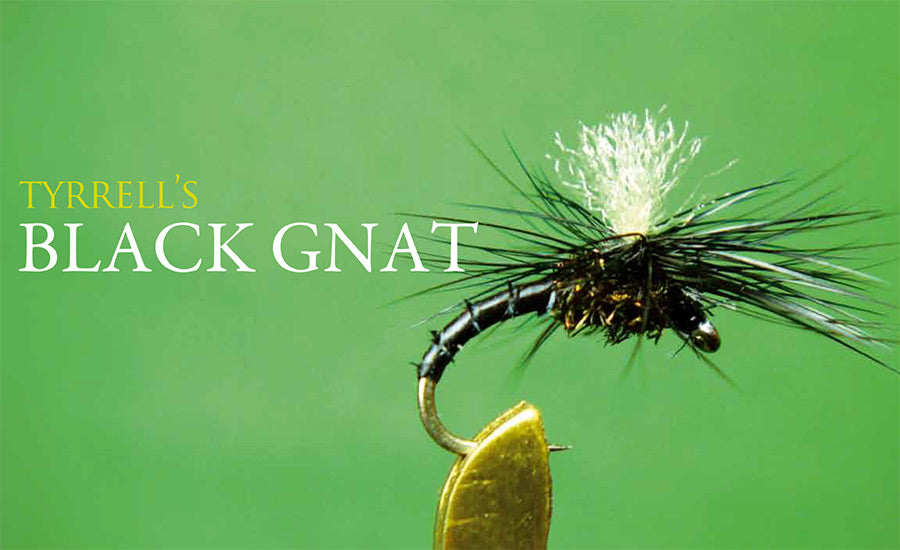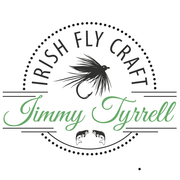Tyrrell's Black Gnat - Irish Angler Magazine June 2011
- by Irish Fly Craft Admin
-

It can be the dread of every fly angler and fly dresser. It can be a tricky fly to imitate and get right. But, says Jimmy Tyrrell, when trout are feeding on them on those warm summer days this pattern will do the trick.
What can be said about this small insect? The name ‘Black Gnat’ can cover a list of different small black flies, hence all the different patterns and sizes that are tied. They range from the large hawthorn fly to the minute reed smuts. If you can come up with a good copy for the insects great sport, but as a preference I would use the fly more for daytime and early evening.
I like to fish dry flies that sit nicely in the surface film, as I think it makes them more realistic to the trout. Even though the insect is terrestrial and lands on the water rather than coming up from the riverbed like the olives, I think it makes the imitation look more realistic to the trout. I just think it looks a lot more realistic in the surface film as the fly is drowning. That’s probably why I fish a lot of emerging patterns as they work really well for me on the rivers. When you see these insects over the water I would say that they are in the act of mating and fall onto the water, or more often they get blown onto the water where the ever-curious trout is lying in wait.
"Gnats come in a variety of different sizes and can be tied down to size 20 or less on some river and lakes and the smaller sizes will definitely work better."
I’ve come up with a dry pattern that has given me some joy on my local rivers during the day. I came up with this pattern some time ago when I was tying some river olives for someone and found a packet of black goose biots that I did not know I had used them to tie up this pattern. Fish it in water that is not moving. Casting the fly into the channels and small pockets can sometimes produce a nice fish. It’s a great way to test your patience and skills, as the trout don’t come that easy to the fly and stealth and a lot of patience are required to try to fool the trout into a take.
In the summer months Black Gnats can be found in their thousands on and around most rivers and loughs, especially around the shorelines of the loughs, and trout will feed on them consistently when they are over the water in great numbers. These insects play a large part of the trout’s diet during the summer, so a couple of good imitations in different sizes are essential in your fly box.
Gnats come in a variety of different sizes and can be tied down to size 20 or less on some river and lakes and the smaller sizes will definitely work better. In the very small sizes it can be used to imitate the angler’s curse, the minute reed smuts which I would imagine play a larger part in the trout’s diet as they are an aquatic insect and can be seen in there hundreds of thousands on and over the water surface. Trout will sometimes feed on these for hours and no other pattern will be taken and more often than not the trout will not even look at any imitations.
Tyrrell's Black Gnat
| Hook: | Size 16 or smaller fine wire grub hook |
| Body: | Black goose biot |
| Thorax: | Bronze peacock herl |
| Hackle: | Black cock |
| Post: | Poly yarn or floss |
Tying Instructions
 Step One: Tie on the tying silk and wind down to the bend of the hook.
Step One: Tie on the tying silk and wind down to the bend of the hook. Step Two: Tie in the coq de Leon feather tail.
Step Two: Tie in the coq de Leon feather tail. Step Three: Cut a thin strip of Thin Skin and tie in at the tail.
Step Three: Cut a thin strip of Thin Skin and tie in at the tail. Step Four: Build up the body to an oval shape with the tying silk.
Step Four: Build up the body to an oval shape with the tying silk. Step Five: Wind up the Thin Skin in overlapping turns and tie off.
Step Five: Wind up the Thin Skin in overlapping turns and tie off. Step Six: Tie in the CDC plumes.
Step Six: Tie in the CDC plumes. Step Seven: Pull the CDC plumes forward and tie in.
Step Seven: Pull the CDC plumes forward and tie in. Step Eight: Pull the remainder of the plumes back with you finger and thumb and tie down.
Step Eight: Pull the remainder of the plumes back with you finger and thumb and tie down. Step Nine: Whip finish and varnish.
Step Nine: Whip finish and varnish.Tying Tips
Tip 1: Keep the area at the eye of the hook as clear as you can until the finishing of the fly.
TIP 2: Do not put on to much hackle: two to three turns are sufficient.
TIP 3: Put a small drop of varnish onto the hook shank before winding on the body.
TIP 4: Wind the goose biot body in touching turns, do not overlap.





